

The History of the Friesian Horse
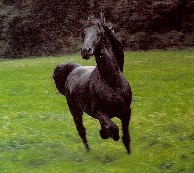
As
one of the world's oldest equine breeds, the Friesian is native to
the northern province of Friesland in The Netherlands, where it is
deemed a national treasure. With powerful muscles beneath its lustrous
black lacquered coat, and a gentle disposition that endears the animal
to those of the two-legged kind, the Friesian has enchanted Europeans
for centuries. Experts suspect that the Friesian's most influential
ancestor was the prehistoric Equus robustus, an enormous horse that
once roamed the region now known as the Netherlands.
The
monks were well known for their horse breeding in the middle ages,
and reputedly crossed the draft-type Equus robustus descendant's
with lighter horse breeds. The result was the Friesian, a horse with
incredible strength and agility, coupled with a willing, kind, yet
lively disposition. These skillful monks created not only one of
Europe's first pure horse breeds but also one of the world's first
warmbloods.
The
Romans were among the first to acknowledge the Friesian as a powerful
working horse. Despite being ugly in their eyes, the strength, docility
and endurance was proved when carrying the German knights to the Crusades.
Later, the Friesian became better looking; contact with the eastern horses
improved the Friesian, as did the infusion of the Andalusian blood when the
Spanish occupied the Netherlands during the Eighty Years' War. The descendents
of this heavy horse were valued as saddle horses by the medieval nobility
and are portrayed by many of the Old Dutch Master-Painters.
In
turn, the Friesian was used to improve other breeds, such as the Oldenburg
that was mainly founded on Friesian blood (and in later years, Oldenburg
blood was used to re-establish the Friesian breed). The New Forest, Dale,
Fell Ponies, the Morgan Horse and from there the Standard bred, Orlov
Trotter, Swedish Warmblood, Kladruber and the Norwegian Dole Gudbrandsdal
were all influenced by the Friesian. Through its derivative, the Old English
Black, the Friesian also influenced England's Great Horse, now known as
the Shire.
Description
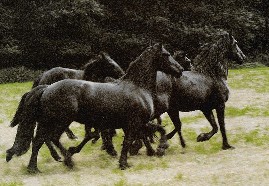 The
Friesian is always jet-black with a long flowing mane and tail, often to
the ground. His action is flamboyant and eye-catching. He can be driven,
ridden, jumped, likes working on the land or performing in the circus,
and is one of the most versatile breeds of the world. The Friesian is a
harmoniously and evenly built horse with a noble head and bright intelligent
eyes, and small attentive ears that are slightly inclining towards each
other. He carries his noble head on a crested neck that is not too short
and slightly bent, continuing on to a strong back, ending in a croup that
is not too short and should not be too slanted. His shoulders are powerful
and slanted, and has long ribs that are well-arched. The arm is well-developed,
and ends with strong legs and feet, accented by a sufficient growth of hair
on the lower foot, a nice crest and a long tail. In short, this is a horse
with a luxuriant and proud appearance, full of temperament, willing to work
and is honest. The height at the shoulder at three years of age of 1.60 meters
is considered ideal. The Friesian has smooth, square, elegant and grand gaits;
the walk should be straight, strong and supple from the powerful hindquarters
swinging forward. The trot should have a roomy forward action, feet lifted
highly, with good power from the hindquarters; the trot should be light
footed with a floating movement and enough flexion in the hock. The canter
is cheerful and sustained with power from the hindquarters and flexion in
the hock.
The
Friesian is always jet-black with a long flowing mane and tail, often to
the ground. His action is flamboyant and eye-catching. He can be driven,
ridden, jumped, likes working on the land or performing in the circus,
and is one of the most versatile breeds of the world. The Friesian is a
harmoniously and evenly built horse with a noble head and bright intelligent
eyes, and small attentive ears that are slightly inclining towards each
other. He carries his noble head on a crested neck that is not too short
and slightly bent, continuing on to a strong back, ending in a croup that
is not too short and should not be too slanted. His shoulders are powerful
and slanted, and has long ribs that are well-arched. The arm is well-developed,
and ends with strong legs and feet, accented by a sufficient growth of hair
on the lower foot, a nice crest and a long tail. In short, this is a horse
with a luxuriant and proud appearance, full of temperament, willing to work
and is honest. The height at the shoulder at three years of age of 1.60 meters
is considered ideal. The Friesian has smooth, square, elegant and grand gaits;
the walk should be straight, strong and supple from the powerful hindquarters
swinging forward. The trot should have a roomy forward action, feet lifted
highly, with good power from the hindquarters; the trot should be light
footed with a floating movement and enough flexion in the hock. The canter
is cheerful and sustained with power from the hindquarters and flexion in
the hock.
The Friesian Around The World
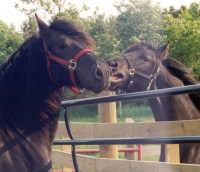
Bauke and Zeusa
| |
The
Friesian is very versatile in all disciplines: from driving , (dressage,
carriage, and pleasure ) plus under saddle (dressage, saddle seat, hunt
seat, and western). Friesians also make good trail and are excellent at
parades. The original Friesian gig, a delightful two-wheeled carriage
from the second half of the eighteenth century with its typical rococo
adornments is traditionally closely connected with the breed. This beautiful
combination considerably enhances its baroque / modern appearance.
The
Friesian Horse used to appear in all of Western Europe, but from about
1900 only in Friesland. Friesland is still the center of breeding, but
at present their popularity is increasing every year; there are now
Friesians in Scotland, France, Germany, America, Yugoslavia, Belgium,
Switzerland, Canada, South Africa, Luxembourg, Ireland, Austria and
Australia. Nowadays, the Friesian is popular in harness and in the show
ring. The Friesian can be found in the circus, because of its striking
carriage and willingness to adapt itself, is also found under saddle,
competing in dressage up to international levels, but its first function
remains supreme. It is a cheerful, loyal, very sensitive all-rounder with
a unique and pleasant character.
The FPS
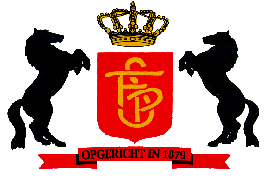 Since
1879, the Friesian Horse has been registered by the Royal Society
"Het Friesch Paarden-Stamboek" (FPS). It is the oldest horse studbook
of The Netherlands; at present a total of some 5000 Friesian horses
are registered in it. Separate registers are kept for fillies and colts,
for mares, stallions and geldings. Fillies and colts are micro-chipped
to prevent confusion. When full grown at the age of three, it can be
entered in the Studbook if there is sufficient quality. On approval,
the horses are then branded with the FPS brands.
Since
1879, the Friesian Horse has been registered by the Royal Society
"Het Friesch Paarden-Stamboek" (FPS). It is the oldest horse studbook
of The Netherlands; at present a total of some 5000 Friesian horses
are registered in it. Separate registers are kept for fillies and colts,
for mares, stallions and geldings. Fillies and colts are micro-chipped
to prevent confusion. When full grown at the age of three, it can be
entered in the Studbook if there is sufficient quality. On approval,
the horses are then branded with the FPS brands.
In
short, the primary aim of the FPS is to promote the Friesian Horse
and to breed horses with fine exteriors yet maintain the typical
racial features that are capable of high performances in both sports
(show driving, driving, dressage under saddle, mixed) and recreation.
This should be done by careful selection within the breed. Firstly,
"breeding horses with fine exteriors" is not the only purpose of the
FPS, as Friesians are not only bought especially for show and driving;
there are many breeders, horse lovers and leisure sports people who
take to the Friesian horse. It is remarkable that even in years when
in many studbooks the number of members and horses dropped, the FPS
showed an increase and still does. The breeding of Friesian horses has
a relative narrow basis with only three lines: the Tetman line, the Age
line and the Ritske line.
The Friesian Horse Association
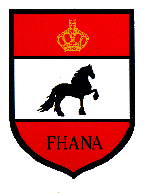
Mapleview is
a member of the
Friesian Horse Associaton
of North America.
|
The
FHANA is the North American representative of the original Friesian
horse association, Friese Paarden Stomboek (FPS). The FPS is recognized
as the European Mother Studbook of the Friesian Horse and is the
worldwide authority on the Friesian Horse.
The
question what the original Friesian horse looked like and how it
developed is difficult to answer. During the Middle Ages, they were
found from Norway to Spain and Western Europe; the knights used these
indigenous horses. These heavy baroque horses can be seen on old pictures
and paintings. This image changed when many Friesian horses were used for
trotting races. After 1920, hard times began for the Friesian horses
(there were only three stallions in 1917) when they were mainly used in
agriculture. Its relatively short legs and high weight (650-700kg) were
two fundamental changes that were bred into the breed. After 1970, the
tractor superseded the horse almost entirely in farm labor. From this time
onwards, the horse was increasingly used as is described in sports and
recreation. Some members who like to see the Friesian as a farm horse and
want to continue breeding it are of course free to do so, especially if the
breeder aims to improve the weak points of the breed. The breeding purpose
is to breed a "Modern Friesian" horse, which still has the typical
characteristics of the breed, but at an improved length of leg; forearm,
and neck, and more animation at all three gaits.
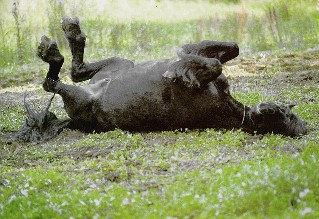

* The pictures of the horse rolling, horse running, and the group of hourses are from the Friesian Horses Book.
|